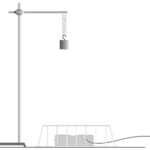Experiments
Here are experiments our science specialists have selected to support the IB* topic.

Simple Harmonic Motion
Experiment #15 from Physics with Vernier
- Measure the position and velocity as a function of time for an oscillating mass and spring system.
- Determine the amplitude, period, and phase constant of the observed simple harmonic motion.
- Compare the observed motion of a mass and spring system to a mathematical model of simple harmonic motion.

Energy in Simple Harmonic Motion
Experiment #17 from Physics with Vernier
- Examine the energies involved in simple harmonic motion.
- Test the principle of conservation of energy.

Pendulum Periods
Experiment #17 from Advanced Physics with Vernier — Mechanics
In this experiment, you will
- Collect angle vs. time data for a simple pendulum.
- Determine the best-fit equation for the angle vs. time graph.
- From an analysis of the forces acting on the pendulum bob, derive the equation describing the motion of the pendulum.
- Relate the parameters in the best-fit equation for the angle vs. time graph to their physical counterparts in the system.
- Determine the period of oscillation from an analysis of the angle vs. time graph.
- Account for the deviation from constant periods when the amplitude becomes large.
- Educational Standard
- International Baccalaureate (IB)
- Subject
- Physics
- Section
- Additional Higher Level (AHL)
- Topic
- 9. Wave phenomena
* The IB Diploma Program is an official program of the International Baccalaureate Organization (IBO) which authorizes schools to offer it. The material available here has been developed independently of the IBO and is not endorsed by it.
